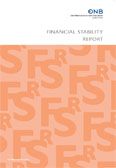Financial Stability Report 44
 OeNB
OeNB
- published:
- November 2022
 OeNB
OeNB
Financial Stability Report 44 (PDF, 4.5 MB) November 2022
Recent Developments (PDF, 752 kB) en Nov 22, 2022, 12:00:00 AM
Nontechnical summaries (in English and German) (PDF, 118 kB) de en Nov 22, 2022, 12:00:00 AM
Financial vulnerabilities and debt at risk of CESEE borrowers: a cross-country analysis (PDF, 859 kB) Enzinger, Koch, Riedl. We employ OeNB Euro Survey data to provide an assessment of the financial vulnerability of indebted households in nine Central, Eastern and Southeastern European (CESEE) economies for the first two years of the COVID-19 pandemic (2020 and 2021). Given the considerable exposure of Austrian banking subsidiaries in this region, it is of crucial policy relevance to swiftly identify potential risks stemming from household debt. Against this background, we calculate debt at risk, i.e. the outstanding debt held by financially vulnerable households as a share of overall outstanding household debt in each country, including nonbank debt. To determine which indebted households are vulnerable, we calculate five different indicators of financial vulnerability commonly used in the literature and combine them into one vulnerability index. Using our vulnerability index, we observe considerable heterogeneity across countries with respect to the debt-at-risk level. In six out of nine countries, vulnerable borrowers hold an overproportionate share of debt. Given the ongoing surge in consumer prices and rising interest rates, constant and in-depth monitoring of credit risks is crucially important. en financial vulnerability, debt at risk, household overindebtedness, CESEE D14, D39, G5, O52 Nov 22, 2022, 12:00:00 AM
Systemic risks of commercial real estate funding in Austria
(PDF, 1.5 MB)
Liebeg, Liegler.
Commercial real estate (CRE) has come under increasing scrutiny by macroprudential as well as microprudential authorities. Our policy paper is embedded in macroprudential policymaking in Austria and informs market participants on the current state of play.
In Austria, bank loans account for the majority of CRE exposures. Furthermore, Austrian banks are more exposed to CRE than banks in other EU banking markets. The growth of aggregate CRE lending to domestic borrowers is elevated, although most Austrian banks remain below critical thresholds. A large share of CRE loans in Austria is undercollateralized and at the same time exhibits high loan-to-value (LTV) ratios. Furthermore, the Austrian banking sector’s high exposure to just a few CRE borrowers combined with below-average ratings of CRE loans warrants the heightened attention of both banks and supervisors. However, rating migrations have so far not shown critical patterns.
Research is under way to investigate the reasons behind high LTV and loan-to-collateral ratios, the impact of higher interest rates and/or an economic downturn on CRE market valuations, the adequacy of loan pricing and risk provisions, improvements of borrower-based indicators and the impact of climate risks and decarbonization.
en
commercial real estate, systemic risk, macroprudential supervision
G18, G21, G28, R30
Nov 22, 2022, 12:00:00 AM
Effects of interest rate and inflation shocks on household vulnerability in Austria: a microsimulation using HFCS data (PDF, 981 kB) Albacete, Gerstner, Geyer, Lindner, Prinz, Woharcik. Motivated by the recent rise in interest rates and high inflation in the euro area, we test households’ resilience against these shocks by performing microsimulations to investigate the impact of these shocks on household vulnerability and on debt at risk. We identify financially vulnerable households in Austria using several vulnerability measures common in the literature and household-level data from the latest wave of the Household Finance and Consumption Survey (HFCS). We find that the inflation shock has a stronger impact on the share of vulnerable households than the interest rate shock. However, the interest rate shock has a stronger impact on debt at risk than the inflation shock: the debt of households becoming vulnerable after the former (typically mortgage debt) tends to be larger than the debt held by households becoming vulnerable after the inflation shock (typically nonmortgage debt). Compared to the euro area, the departing levels of household vulnerability and debt at risk are much lower in Austria. The impact of a combined scenario is similar in both regions. en macroprudential risk assessment, household vulnerability, stress tests, HFCS D10, D14, E44, G10, G21 Nov 22, 2022, 12:00:00 AM
DuPont reloaded: the profitability of the Austrian banking sector and the impact of the COVID-19 pandemic (PDF, 595 kB) Gruber, Kavan. This short study follows up on our previous paper that analyzed the profitability of Austrian banks’ subsidiaries in Central, Eastern and Southeastern Europe (CESEE) from 2004 to 2016 on the basis of a DuPont analysis.2 Now, we not only update the time frame to include years before and during the COVID-19 pandemic (2017 to 2021), but also look at the entire Austrian banking sector. In addition, we explain trends in banks’ net interest income in more detail by analyzing to what extent it depends on price and volume effects. We find that banks’ return on equity dropped substantially during 2020 but bounced back to pre-pandemic levels in 2021. The obvious driver were risk costs, which spiked at first but quickly calmed down again as the impact of the pandemic proved to be less severe than originally expected. Also, banks’ net interest margin was negatively affected during the pandemic, both by low interest rates and banks’ shift toward lower-margin business. The future development of profitability in the Austrian banking sector is highly uncertain. But even though – like in the past few years – much will depend on external factors, including monetary, fiscal and prudential decisions as well as geopolitical developments, our analysis suggests that the Austrian banking sector is well prepared to weather these challenging times. en bank, profitability, Austria, CESEE, DuPont analysis, net interest income G21 Nov 22, 2022, 12:00:00 AM
Key financial indicators (PDF, 210 kB) en Nov 22, 2022, 12:00:00 AM
Key financial indicators (XLSX, 91 kB) en Nov 22, 2022, 12:00:00 AM